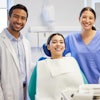
After two years of planning, California has finally offered a look at what the state's oral health plan may be like. The state's dental director, Jayanth Kumar, DDS, MPH, outlined broad concepts and frameworks for the plan in the August 2017 edition of the Journal of the California Dental Association.
 Jayanth Kumar, DDS, MPH.
Jayanth Kumar, DDS, MPH.In an introduction and article in the journal, Dr. Kumar provides an idea of what may be included in the plan. For instance, the plan will consist of measurable objectives and likely focus on preventive care. It is scheduled to be released by the end of 2017.
"With the availability of annual funding in the amount of $30 million for supporting the implementation of the state oral health plan, there is a unique opportunity to build the capacity of [local health departments] to implement oral health programs," he wrote (J Calif Dent Assoc, August 2017, Vol. 45:8, pp. 395-403). "It is critical that private practitioners lend their expertise to guide the development and promotion of these initiatives to achieve improvements in oral health."
Coming up with the plan
The California Budget Act of 2014 specifically allocated funds to the California Department of Public Health (CDPH) for the development of a plan that addresses oral health disparities in the state. Dr. Kumar then joined CDPH in 2015 to spearhead the plan's creation and implementation. In the two years since he was brought on, little has been known about what the 10-year plan will include. That is, until his introduction and article in the current CDA journal.
In his writings, Dr. Kumar broadly outlined the following issues that the state oral health plan will focus on:
- Creating infrastructure to support oral health goals
- Supporting early prevention and detection programs
- Making it easier for residents to find dental homes
- Educating patients and healthcare personnel about oral health
- Shifting the focus of dental Medicaid to prevention
- Training dentists to care for vulnerable populations
- Working with existing stakeholders to improve oral health
- Creating data systems to monitor progress
“It is critical that private practitioners lend their expertise to guide the development and promotion of these initiatives to achieve improvements in oral health.”
Dr. Kumar seemed particularly interested in early childhood oral health education and preventive care. One of the few concrete ideas mentioned was a kindergarten oral health screening and sealant program, a program that already exists in San Francisco and has effectively helped reduce caries incidence from 60% to 34% in 10 years. The statewide average for kindergarten caries is 50%, he noted.
"The evidence base for implementing preventive programs is stronger for public health interventions focused on children when compared to the elderly," a CDPH spokesperson told DrBicuspid.com. "State oral programs look for guidance from the Community Guide developed by the Taskforce on Community Preventive Services and the U.S. Preventive Services Taskforce."
Dr. Kumar also intends to work with the U.S. Centers for Disease Control and Prevention (CDC) and territorial dental directors to develop a framework to collect, analyze, and interpret oral health data for the specific purpose of guiding public health policy. This infrastructure creation will help monitor the plan's progress.
Furthermore, the plan will address the Dental Transformation Initiative (DTI), a $740 million, five-year plan to overhaul California's dental Medicaid program, Denti-Cal. The DTI has already begun implementing strategies to shift the focus from restorative care to preventive care, including reimbursing the use of silver diamine fluoride for the first time.
"The Dental Transformation Initiative presents a unique opportunity to increase preventive dental services to children who are enrolled in the Medi-Cal program and will demonstrate innovative local solutions," the CDPH spokesperson stated. "The DTI will be addressed in the state plan."
Support needed from practicing dentists
Dr. Kumar stressed that the state can't make the changes alone. He called on practicing dentists to help guide and support the upcoming plan, particularly at the local level by working with local health departments to champion oral health in their communities.
"Practicing dentists possess unique professional skills, experience, and knowledge and are, therefore, essential partners needed to help guide the development of new service delivery initiatives to increase access to care," he wrote.
In his article, Dr. Kumar listed several examples of ways dentists may be able to help with the plan's goals, such as providing care in community centers, particularly schools, as well as federally qualified health centers. He also mentioned teledentistry as an option to improve access to care.
The CDPH spokesperson added that private practitioners can already begin making a difference by helping to promote interventions, including community water fluoridation and school-based programs. Dentists can also enroll in Denti-Cal, he noted.
"Private practitioners can assist local health departments in carrying out the essential public health services by playing a significant role in educating about the importance of oral health and informing the community about steps they can take to prevent dental diseases," the CDPH spokesperson stated.


















